The Dom are descendants of the Dom caste with origins in the Indian subcontinent which through ancient migrations are found scattered across the Middle East and North Africa, the Eastern Anatolia Region, and parts of the Balkans and Hungary. The traditional language of the Dom is Domari, an endangered Indo-Aryan language, thereby making the Dom an Indo-Aryan ethnic group.
The Ashkali, otherwise known as Hashkali and/or Balkan Egyptians, are Albanian-speaking Muslim ethnic cultural minorities, which mainly inhabit Kosovo and southern Serbia, as well as Albania, Montenegro, and North Macedonia. Prior to the Kosovo War of 1999, the Balkan Egyptians or Ashkali people registered themselves as Albanians. While some Ashkali speak Romani language, Egyptians usually do not. The two groups are not clearly delineated. On the other hand, they differ linguistically and culturally from the Roma, even though they have often been grouped together under the acronym RAE.

Islam arrived in Albania mainly during the Ottoman period when the majority of Albanians over time converted to Islam under Ottoman rule. Following the Albanian National Awakening (Rilindja) tenets and the deemphasizing of religion during the 20th century, the democratic, monarchic, and later the communist governments followed a systematic dereligionization of the Albanian nation and national culture. Due to this policy, Islam, as with all other faiths in the country, underwent radical changes. Decades of state atheism, which ended in 1991, brought a decline in the religious practice of all traditions. The post-communist period and the lifting of legal and other government restrictions on religion allowed Islam to revive through institutions that generated new infrastructure, literature, educational facilities, international transnational links and other social activities. According to a 2011 census, 56.7% of Albania's population adheres to Islam, making it the largest religion in the country. For contemporary Muslims in Albania, Muslim religious practices tend to be minimal. The remaining population belongs either to Christianity, which is the second largest religion in the country practiced by 16.99% of the population, or are irreligious.
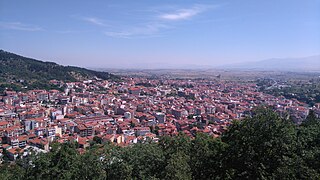
Florina is a town and municipality in the mountainous northwestern Macedonia, Greece. Its motto is, 'Where Greece begins'.

Bilisht is a town and a former municipality in Korçë County, south-eastern Albania. At the 2015 local government reform it became a subdivision and the seat of the municipality Devoll. It was the seat of the former Devoll District. The population at the 2011 census was 6,250. The town is 9 km from the border with Greece at Kapshticë. The closest Greek village across the border is Krystallopigi in the Florina regional unit. Bilisht is at 890 meters above sea level and has a continental climate with cool summers and cold winters. It serves as an economic centre for the local agriculture, mining, food and textile industries. The football club is Bilisht Sporti.
The Romani in Spain, generally known by the endonym Calé, or the exonym gitanos, belong to the Iberian Romani subgroup known as Calé, with smaller populations in Portugal and in Southern France. Their sense of identity and cohesion stems from their shared value system, expressed among gitanos as las leyes gitanas.

The Romani people are a distinct ethnic and cultural group of peoples living all across the globe, who share a family of languages and sometimes a traditional nomadic mode of life. Though their exact origins are unclear, central India is a notable point of origin. Their language shares a common origin with, and is similar to, modern-day Gujarati and Rajasthani, borrowing loan words from other languages as they migrated from India. In Europe, even though their culture has been victimized by other cultures, they have still found a way to maintain their heritage and society. Indian elements in Romani culture are almost non-existent, with the exception of their language. Romani culture focuses heavily on family. The Roma traditionally live according to relatively strict moral codes. The ethnic culture of the Romani people who live in central, eastern and southeastern European countries developed through a long, complex process of continuous active interaction with the culture of their surrounding European population.
Albanisation, Albanianisation (UK), Albanization, or Albanianization (US) is the spread of Albanian culture, people, and language, either by integration or assimilation. Diverse peoples were affected by Albanisation including peoples with different ethnic origins, such as Turks, Serbs, Croats, Circassians, Bosniaks, Greeks, Aromanians, Ashkali and Balkan Egyptians, Romani, Gorani, and Macedonians from all the regions of the Balkans.

Romani people in Bulgaria constitute Europe's densest Roma minority. The Romani people in Bulgaria may speak Bulgarian, Turkish or Romani, depending on the region.

Anti-Romani sentiment is a form of bigotry which consists of hostility, prejudice, discrimination, racism and xenophobia which is specifically directed at Romani people. Non-Romani itinerant groups in Europe such as the Yenish, Irish and Highland Travellers are frequently given the name "gypsy" and as a result, they are frequently confused with the Romani people. As a result, sentiments which were originally directed at the Romani people are also directed at other traveler groups and they are frequently referred to as "antigypsy" sentiments.
In Romani culture, a gadjo (masculine) or gadji (feminine) is a person who has no Romanipen. This usually corresponds to not being an ethnic Romani, but it can also be an ethnic Romani who does not live within Romani culture. It is often used by Romanies to address or denote outsider neighbors living within or very near their community.
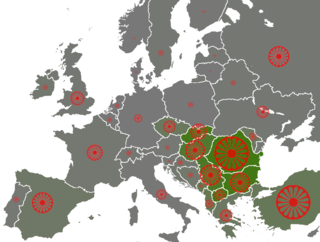
The Romani people have several distinct populations, the largest being the Roma and the Calé, who reached Anatolia and the Balkans in the early 12th century, from a migration out of the Indian subcontinent beginning about 1st century – 2nd century AD. They settled in the areas of present-day Turkey, Greece, Serbia, Romania, Croatia, Moldova, Bulgaria, North Macedonia, Hungary, Albania, Kosovo, Bosnia and Herzegovina, Czech Republic, Slovenia and Slovakia, by order of volume, and Spain. From the Balkans, they migrated throughout Europe and, in the nineteenth and later centuries, to the Americas. The Roma population in the United States is estimated at more than one million.
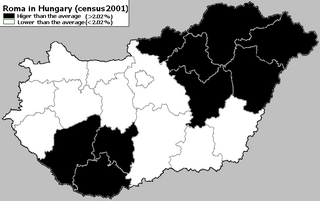
Romani people in Hungary are Hungarian citizens of Romani descent. According to the 2011 census, they comprise 3.18% of the total population, which alone makes them the largest minority in the country, although various estimations have put the number of Romani people as high as 8.8% of the total population. They are sometimes referred as Hungarian Gypsies, but that is sometimes considered to be a racial slur.
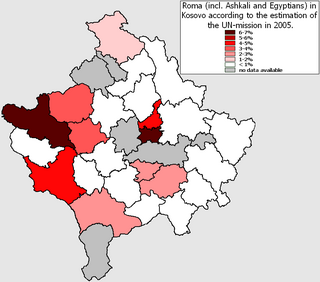
Romani people in Kosovo are part of the wider Romani people community, the biggest minority group in Europe. Kosovo Roma speak the Balkan Romani language in most cases, but also the languages that surround them, such as Serbian and Albanian. In 2011 there were 36,694 Romani, Ashkali and Balkan Egyptians living in Kosovo. However, the minorities are unrelated to each other and were only put together based on appearance.

Muslim Romani people are people who are ethnically Roma and profess Islam. There are many different Roma groups and subgroups that predominantly practice Islam, as well as individual Romani people from other subethnic groups who have accepted Islam. Xoraxane Roma in Balkan Romani language, are non-Vlax Romani people, who adopted Sunni Islam of the Hanafi madhhab at the time of the Ottoman Empire. Some of them are Derviş of Sufism belief, and the biggest Tariqa of Jerrahi is located at the largest Arlije and Gurbeti Muslim Roma settlement in Europe in Šuto Orizari, locally called Shutka in North Macedonia have their own Romani Imam and the Muslim Roma in Šuto Orizari use the Quran in Balkan Romani language. Many Romanlar in Turkey, are members of the Hindiler Tekkesi a Qadiriyya-Tariqa, founded in 1738 by the Indian Muslim Sheykh Seyfullah Efendi El Hindi in Selamsız. Roma Muslims in Turkey and the Balkans are mostly cultural Muslims or nominal Muslims.
The Romani people in Turkey or Turks of Romani background are Turkish citizens and the biggest subgroup of the Turkish Roma. They are Sunni Muslims mostly of Sufi orientation, who speak Turkish as their first language, in their own accent, and have adopted Turkish culture. Many have denied their Romani background over the centuries in order to establish a Turkish identity, to become more accepted by the host population. They identify themselves as Turks of Oghuz ancestry. More specifically, some have claimed to be members of the Yörüks, Amuca, Gajal or Tahtacı.
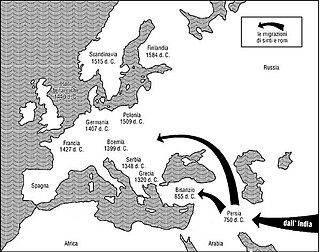
The Romani people, also known as the Roma, qualify as an ethnic minority group in Poland of Indo-Aryan origins. The Council of Europe regards the endonym "Roma" more appropriate when referencing the people, and "Romani" when referencing cultural characteristics. The term Cyganie is considered an exonym in Poland.
The Islamization of Albania occurred as a result of the Ottoman conquest of the region beginning in 1385. The Ottomans through their administration and military brought Islam to Albania through various policies and tax incentives, trade networks and transnational religious links. In the first few centuries of Ottoman rule, the spread of Islam in Albania was slow and mainly intensified during the seventeenth and eighteenth centuries due in part to greater Ottoman societal and military integration, geo-political factors and collapse of church structures. It was one of the most significant developments in Albanian history as Albanians in Albania went from being a largely Christian population to one that is mainly Sunni Muslim, while retaining significant ethnic Albanian Christian minorities in certain regions. The resulting situation where Sunni Islam was the largest faith in the Albanian ethnolinguistic area, but other faiths were also present in a regional patchwork, played a major influence in shaping the political development of Albania in the late Ottoman period. Apart from religious changes, conversion to Islam also brought about other social and cultural transformations that have shaped and influenced Albanians and Albanian culture.

Islam in Albania (1913–1944) was characterised by an increasing secularisation of Albanian society which had begun with Albanian Independence in 1912 carrying on influences from the Albanian National Awakening. During the interwar period, new local Muslim institutions such as the Muslim Community of Albania arose that severed ties with the Ottoman Caliphate and placed a focus on localising Islam in Albania. The Albanian state also played a significant role in that process through state interference and pressuring the uptake of reforms by those institutions and wider Muslim society. Measures that were adopted were banning the veil and others which were interpreted as modernising Albania. These events caused tensions within parts of Muslim society between conservatives and those who viewed themselves as progressives which caused discussions and reflections about the future role of Islam in Albania and Albanian identity. The interwar era also saw Sufi Islam expand in Albania with various orders gaining new adherents with the largest, the Bektashi Order moving its world headquarters to Albania.
The oldest settled group are the Kovači (Blacksmiths), a subgroup of the Arlije, who have lived there since the Middle Ages and who converted to Islam during the Ottoman period, they do not speak Balkan Romani, but rather Montenegrin language or Albanian language, they live especially in the towns of Bar, Montenegro and Ulcinj. They do not want to be called Roma and distance themselves from other Roma groups. They have no roma traditions. They call themselves only as Muslims.











